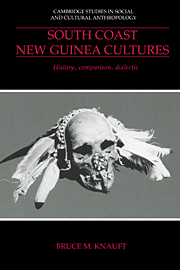Book contents
- Frontmatter
- Contents
- List of figures
- List of tables
- Acknowledgments
- 1 Language-culture areas of south coast New Guinea
- Part 1 Grounding
- Part 2 Critique
- 3 Sexuality in the regional analysis of south New Guinea
- 4 The analytic legacy of homosexual emphasis: language, subsistence, and political economy
- 5 Women's status
- 6 Trends in comparative analysis
- Part 3 Reconfiguration
- Appendix: evidence concerning Asmat homosexuality
- Notes
- List of references
- Index
- Cambridge Studies in Social and Cultural Anthropology
6 - Trends in comparative analysis
from Part 2 - Critique
Published online by Cambridge University Press: 04 December 2009
- Frontmatter
- Contents
- List of figures
- List of tables
- Acknowledgments
- 1 Language-culture areas of south coast New Guinea
- Part 1 Grounding
- Part 2 Critique
- 3 Sexuality in the regional analysis of south New Guinea
- 4 The analytic legacy of homosexual emphasis: language, subsistence, and political economy
- 5 Women's status
- 6 Trends in comparative analysis
- Part 3 Reconfiguration
- Appendix: evidence concerning Asmat homosexuality
- Notes
- List of references
- Index
- Cambridge Studies in Social and Cultural Anthropology
Summary
Chapters 3–5 above illustrate several tendencies in the comparative analysis of ethnographic regions:
1 Particularly on initial analysis, the features considered “characteristic” of a culture area tend to emerge through explicit or implicit contrast with other areas.
Every “figure” requires a “ground.” For instance, Melanesia emerged as the region of “Big Man” societies particularly when configured against the “chiefdoms” of Polynesia (Sahlins 1963); interior areas of New Guinea were seen as “secular” in comparison with the “religious” bent of the coastal seaboard (Lawrence and Meggitt 1965). More recently, the New Guinea south lowlands have been asserted to have “low politicoeconomic intensity” and to be “homosexual” and “manhood emphasizing” when configured against the “high politicoeconomic intensity,” “heterosexuality,” and “clanship” of the highlands.
To a significant extent these assessments stem from the terms of contrast themselves. How different south New Guinea fertility cult and sexual practices would seem if configured by regional contrast to northern Australia, native America, or lowland Amazonia, as opposed to the New Guinea highlands. How different the characterizations of highland New Guinea political or religious systems would be if configured as variants of the power-dominant or “open” status systems of Polynesia, rather than as a polar contrast between “Big Men” or “Great Men” and “chiefs” (cf. Goldman 1970).
- Type
- Chapter
- Information
- South Coast New Guinea CulturesHistory, Comparison, Dialectic, pp. 117 - 126Publisher: Cambridge University PressPrint publication year: 1993



